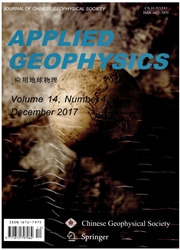

 中文摘要:
中文摘要:
我们是否用声学的记载的工具测量阶段或组速度,仍然被说服。在这份报纸,三种模型被用来由理论分析和数字模拟调查这个问题。首先,我们使用与不同速度包含二个飞机波浪的飞机波浪重叠模型并且能改变阶段速度和组速度的价值。数字结果看那阶段速度是否比组速度更高或低,用缓慢时间连贯(STC ) 我们能仅仅给阶段速度的方法。根据分散分析和分支切割集成的结果,当组速度由到达时间拣获得了时,第二在僵硬边界地上凿穿为分散曲线的结果和 STC 方法获得的速度是阶段速度的一阶的模式表演的波形建模。最后,偶极子登录一个慢形成模型用分散分析和真实轴的集成被调查。分散曲线和完整的波浪火车的结果与僵硬边界条件作为地上凿穿模型显示出类似的结论。
 英文摘要:
英文摘要:
It is still argued whether we measure phase or group velocities using acoustic logging tools. In this paper, three kinds of models are used to investigate this problem by theoretical analyses and numerical simulations. First, we use the plane-wave superposition model containing two plane waves with different velocities and able to change the values of phase velocity and group velocity. The numerical results show that whether phase velocity is higher or lower than group velocity, using the slowness-time coherence (STC) method we can only get phase velocities. Second, according to the results of the dispersion analysis and branch-cut integration, in a rigid boundary borehole model the results of dispersion curves and the waveforms of the first-order mode show that the velocities obtained by the STC method are phase velocities while group velocities obtained by arrival time picking. Finally, dipole logging in a slow formation model is investigated using dispersion analysis and real-axis integration. The results of dispersion curves and full wave trains show similar conclusions as the borehole model with rigid boundary conditions.
 同期刊论文项目
同期刊论文项目
 同项目期刊论文
同项目期刊论文
 The Chebyshev spectral element method using staggered predictor and corrector for elastic wave simul
The Chebyshev spectral element method using staggered predictor and corrector for elastic wave simul A transient method for measuring the gas volume fraction in a mixed gas-liquid flow using acoustic r
A transient method for measuring the gas volume fraction in a mixed gas-liquid flow using acoustic r 期刊信息
期刊信息
